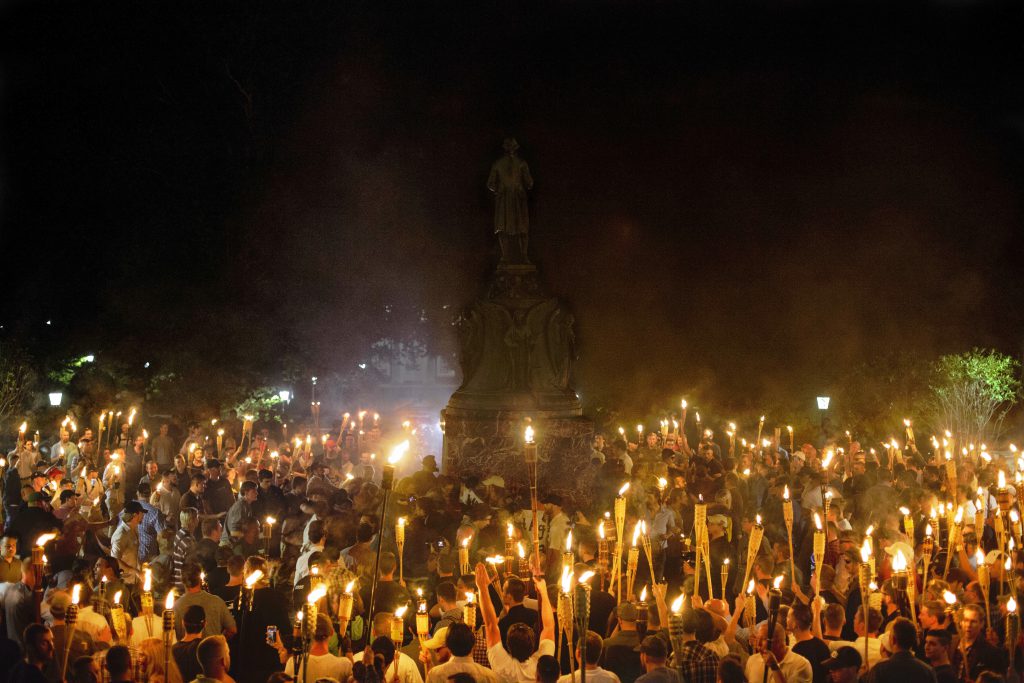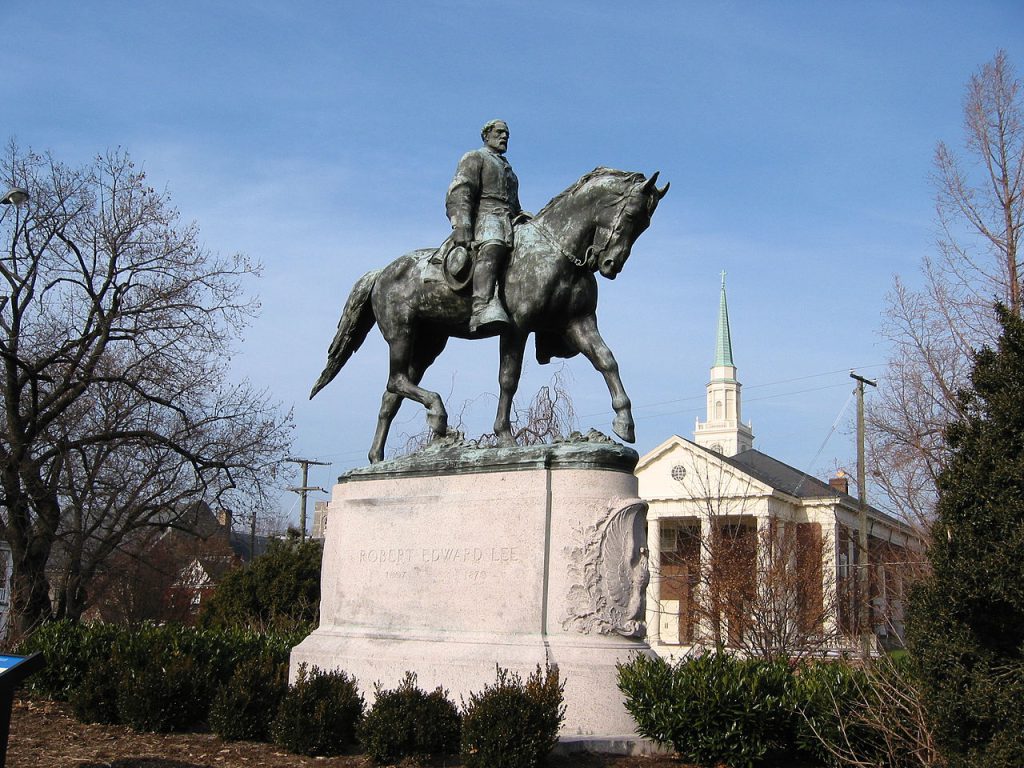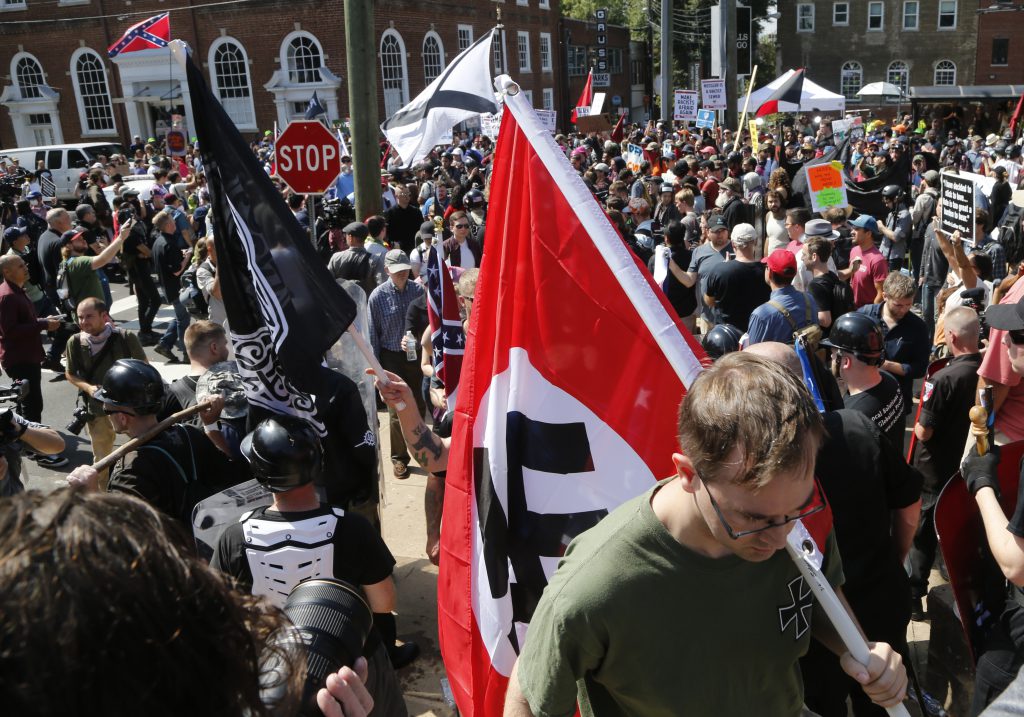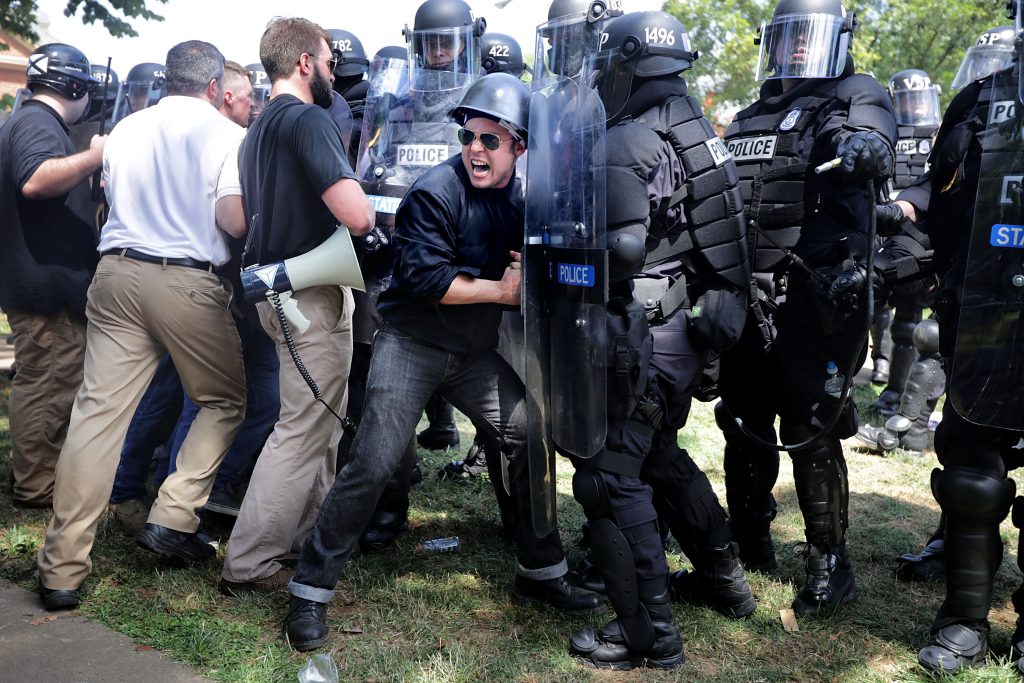Three Lessons I Learned From Charlottesville

On the evening of August 11, a torch-bearing mob assaulted students at the University of Virginia in Charlottesville, where I am an associate professor of anthropology. Prior to the attack, some 300 white supremacists had gathered in a field, lit their tiki torches, and marched across the historic main lawn, raising their fists and chanting Nazi and Ku Klux Klan slogans. When they arrived at the statue of the university’s founder, Thomas Jefferson, they quickly encircled a group of about 20 students who held a banner in peaceful protest opposing white supremacy. The white supremacists shouted at the students and then started attacking them physically, swinging their torches and fists, throwing fire and punches, and shooting pepper spray.
This surprise attack was the prelude to a still more violent demonstration the next day in downtown Charlottesville. White supremacists were in the city to oppose the removal of a statue depicting Confederate Gen. Robert E. Lee. Their “Unite the Right” rally aimed to bring neo-Confederates and U.S. President Donald Trump supporters—in the far right’s parlance, “flaggers” and “normies”—together with hardcore white supremacists and neo-Nazis under the umbrella of the so-called alt-right.
Organizers of the rally hoped that these different constituencies would find unity in a shared feeling of being aggrieved by African-Americans, immigrants, Jews, leftists, feminists, “queers,” and others who they consider to be nonwhite—and who they blame for taking away their rights, jobs, privileges, potency, guns, “greatness,” and so on.
But the hoped-for convergence of “normies” with extreme white supremacists and neo-Nazis did not happen. The protesters in Charlottesville were a mix of neo-Nazi die-hards, far-right militias, and zealous white supremacist groups that are overtly sexist and racist, believing that whites constitute a “race” with its own patriarchal “culture” that is superior to the culture of other “races.” Many in these groups use this belief to argue for a white-male-dominant social system or “nation” that grants whites greater legal rights and excludes or subordinates those deemed to be nonwhite—hence the common term “white nationalist.” Many of these extreme white supremacists idealize the U.S. antebellum South or Nazi Germany. While the “alt-right” tries to make this toxic white supremacist ideology appear palatable by packaging it with a glossy social media sheen of ironic memes, its core supporters are neo-Nazis who advocate racist repression in an authoritarian white-dominant state.
Before the rally began, fierce brawls with sticks, pepper spray, and projectiles broke out between the demonstrators and counterprotesters. A state of emergency was declared, and police cleared the area as the formal rally was canceled. Soon after, a neo-Nazi used a car as a terrorist weapon to run down peaceful counterprotesters. Many people were injured and a young woman, Heather Heyer, was killed in the car attack. These events of August 11 and 12 have received national and international media coverage, and have rightly provoked outrage in many quarters.
Sadly, more such shocking displays in the name of building a white supremacy movement are probably yet to come. As I write this, another torchlit demonstration was held by white supremacists at the Lee statue on October 7. It is naïve to think that this is solely about Confederate statues in and of themselves. Such “white pride” demonstrations are not isolated to this region of the country—white supremacists have been organizing ever more brazen spectacles to extend their media reach and influence across the U.S. The August events in Charlottesville raised the curtain on a newly aggressive white racism that stokes white aggrievement and aims to undo civil rights progress and destroy multicultural tolerance.
I am a Jew who lives in Charlottesville, and I am close to many who took part in the counterprotests or were affected by the events and their aftermath. Although life has outwardly returned to normal, many who reside here remain deeply troubled by the intense racially motivated violence that took place in spaces and streets we traverse every day. The overtness of the racism has exposed old wounds and pressurized old fissures. We are not only feeling the effects of the explicit trauma, we are also experiencing moral trauma: Many in the community are troubled by our own internal conflicts and by the shortcomings—grasped only in hindsight—of our collective response to the extraordinary challenges of those two days.
Given that white supremacist actions will likely continue, I want to convey three lessons from our painful struggles in Charlottesville that may help other communities.
Avoidance Is Not the Answer
In preparation for the preplanned white supremacist rally in the city on August 12, University of Virginia President Teresa Sullivan advised students, faculty, and staff to avoid the demonstration. She asked all of us to consider the objectives spelled out by one white supremacist, who stated, “We should aim to draw the SJWs [social justice warriors] out in Charlottesville and create a massive polarizing spectacle. … They will reveal themselves to be violent, intolerant, opposed to free speech, the insane enforcers of political correctness, etc.” In citing this statement, Sullivan argued that “to approach the rally and confront the activists would only satisfy their craving for spectacle.” And she noted, “The organizers of the rally want confrontation; do not gratify their desire.”
Many in the community, including myself, took her advice, while others prepared to directly respond. They trained in advance and were supported during the protest by teams who provided them with safe spaces, water, food, first aid, post-trauma care, and legal help. In addition, interfaith prayer gatherings were held at various places throughout the town.
Initially I was sympathetic to Sullivan’s idea that we should not give the white supremacists the attention they seem to seek. But I am now convinced that the counterprotesters were right to directly and actively oppose the white supremacist demonstration. While white leaders like Sullivan recommended avoidance to prevent people from getting hurt and to retain control of the media narrative, many local activists and people of color were attuned to the immediate and painful repercussions of racial intimidation—against which they organized in defense.
The white supremacists who gathered in Charlottesville not only sought publicity, they also wanted to directly intimidate people who they despise by aggressively staking an exclusionary white racist claim to public space. They chanted the slogans “Blood and soil,” “Fuck you, faggots,” “Jews will not replace us,” “End immigration,” and “Whose streets? Our streets!”—all of which are speech acts that claim public space as heteronormative white space and threaten to dispossess Jews, African-Americans, immigrants, and those who are LGBTQ.
During the day on Saturday, the heavily armed white supremacists who converged on Charlottesville went into a mostly black neighborhood, Friendship Court, and also hovered around a downtown synagogue. A threat was tweeted to torch the synagogue at 3 p.m. One reply on the neo-Nazi website where it was posted read, “We must not slacken! SIEG HEIL,” according to the Washington Post.
Far from being isolated incidents, these menacing actions reasserted patterns of public racial terror rooted in history. The white supremacists marched through town giving “heil Hitler” salutes while holding Nazi flags, for example. At night they marched with torches, evoking a lynch mob. And to many Charlottesville locals, the statue they were defending is itself a relic of racial intimidation. It was erected in a year, 1924, when the Ku Klux Klan held open parades in Charlottesville and burned at least 10 crosses, some near historically black neighborhoods, and when Virginia enacted its infamous Racial Integrity Act, prohibiting interracial marriage by the “one drop rule.” The statue is in fact an artifact of that resurgent white supremacy movement, which invented the idealized vision of the Confederate “lost cause” while subjecting blacks to tightened Jim Crow legal restrictions, segregation, disenfranchisement, and racial terror.
Acts that revive such terror must be countered by an overwhelming show of solidarity with those who are targeted. It is wrong to passively watch such racial harassment transpire. Staying away grants power and privilege to white racists—allowing them to lay claim to public space—and it leaves people vulnerable to intimidation and attack.
Distinguish Free Speech From Intimidation
The right to free speech has loomed large in public discussions of the Charlottesville tragedy. Many organizations and leaders have issued statements affirming the right to free speech even as they denounced the white supremacists’ hateful message and violence.
But in Charlottesville, rally organizers cannily manipulated the First Amendment protection of speech in order to incite violence. They presented themselves as peaceable “speakers” who face strong opposition and thus need state protection because of the way others respond to the content of their ideas. By compelling the state to protect them on First Amendment grounds, they expected to have a police cordon guarding them, which would palpably manifest the historical pattern of state and police support for racial suppression. Through obtaining such support for themselves, they sought to antagonize the counterprotesters—many of whom interpret police defense of white supremacists as merely the latest in a long history of masked racist abuse—and they fully expected that some of the counterprotesters would attack the police as their apparent allies.
In Charlottesville, rally organizers cannily manipulated the First Amendment protection of speech in order to incite violence.
The violence that the rally organizers wanted to provoke was thus between police and counterprotesters. A previous march by KKK demonstrators on July 8 to protest the removal of Charlottesville’s Confederate monuments used this playbook. The Klan’s numerically pitiful presence was magnified by an imposing police force that protected them from—and stood facing—the much larger body of counterprotesters. That the Charlottesville police upset their plan on August 12 by not positioning themselves as a cohesive, area-wide shield for the ralliers against the counterprotesters shows the importance of understanding—and altering—this dynamic.
From a legal standpoint, the recent events in Charlottesville also revealed that the First Amendment right to “free speech” can be undermined by the Second Amendment right to bear arms, particularly in states like Virginia, where the latter is used to permit the “open carry” of guns.
Rally organizers presented themselves simultaneously as peaceable speakers and as peaceable arms bearers. But when protesters arrive armed to the hilt, weaponizing their message with deadly force, we have to consider what they are “saying.” They are no longer peaceable speakers. They are using intimidating force to threaten others, in effect chilling other people’s rights of response and expression.
This kind of weaponized intimidation was on vivid display in Charlottesville. The white supremacist marchers wore helmets and body armor. They held semiautomatic assault rifles, sniper gear, pistols, clubs, bats, knives, and spray canisters. They combined their display of symbols such as Confederate flags and swastikas, evoking fear-inducing memories of past racial violence, with a palpable threat of violence that was grave, extreme, and immediate.
Is a show of deadly force “speech”? Do the terms of the First Amendment give license to abuse and intimidate others on the basis of their identity? We need to understand that while the First Amendment gives people the right to express unpopular ideas in public, it does not mean that they can do so and hold a weapon at the same time.
But legal permissibility is not the only thing to consider. The signature strategy of the “alt-right” is to force free speech showdowns in order to claim aggrievement at the hands of others who are intolerant of them. They widely publicize this as a politically legitimate grievance—but it distracts attention from the noxious substance of their ideas.
In our portrayals and rhetoric, we need to avoid playing into the free speech frame’s limitations of focusing attention almost exclusively on the white supremacist speaker and his (or, more rarely, her) rights. We should direct more attention to those the speech is intended to intimidate and harm—the people whose own abilities to express themselves (and worship) are curtailed by the speaker’s activities.
We need to take better care to distinguish between a right to expression, which ought to be protected, and noxious intimidation, which is indefensible. When the intent of a group or individual is in fact to intimidate, we need to reconsider how we frame their status as “speakers.” We can permit speech legally while showing massive public disapproval of the message and manner of speaking.
Don’t Expect—or Call for—Unity
Disagreements about tactics, principles, and even questions of fact are not going away. In the aftermath of the violence, many thoughtful people in Charlottesville hold cogent but irreconcilable views, as is true throughout the U.S.
It is often said, in response to tragedy, that people should unify. But even in a community as small as Charlottesville, many groups find it challenging to form alliances, let alone to unify. As some people of color have pointed out, white people who assail white supremacists often do not acknowledge that white supremacy is a pervasive condition that they also benefit from and may unwittingly reproduce.
We need to take better care to distinguish between a right to expression, which ought to be protected, and noxious intimidation, which is indefensible.
There are also sharp disagreements that go beyond the differential experience of race: Is it productive or counterproductive to forcibly prevent some people from speaking? Is it better to respond to violence with violence or with nonviolence? Should attempts to fight racism address the economic inequality that feeds it, or is that a distraction?
Given people’s deeply held differences, calls for unity are themselves often divisive: unity on whose terms (white liberals’? civil libertarians’? the Black Lives Matter movement’s? antifa’s?)? Even when well-intentioned, such calls may be experienced by the groups that are expected to fall in line as bids to silence them. Calls for unity are often asserted by those in power and can serve as a substitute for actually listening to the voices of those at the margins.
The real question is not whether we can come together but rather: How can we help one another while holding to our commitment to live with difference and disunity?
Franz Boas, one of the founders of American anthropology, who devoted much of his life to refuting pseudo-scientific ideas about race and white superiority, rightfully advocated: We need to resist the seduction of speaking about human diversity only in terms of what is universal and shared because that paradoxically eclipses differences, making them disappear behind a single idea. In his work, he aimed to make vivid the particularities of specific people and groups, lending each its own value.
What Boas, among many others, showed us is that unity is not the sole possibility for deep human entanglement. We can understand and accept others even where we disagree and diverge. And we can speak more openly and tolerantly about the irreducible facts of different people’s histories, experiences, politics, and cultures.
Indeed, as the rally demonstrated, even the far right is not unified. At least some of the demonstrators who came left early, surprised by the racist vitriol they heard from the neo-Nazi protesters who shouted racial slurs and called for a “race war,” ethnic cleansing, and genocide. Since August 12, there has been all manner of infighting among rally organizers.
It is troubling that racial intimidation has in fact become a major thrust of U.S. popular politics that is promoted at the highest levels of government. It motivates immigration enforcement, voter restriction efforts, the rollback of policing and sentencing reforms, and the attack on affirmative action in higher education.
But this resurgent politics of white supremacist intimidation won’t go away by itself. We need to help one another by confronting it at every turn. We should not conflate pernicious acts of intimidation with permissible debate and the expression of ideas. And we have to be wise to the pitfall of calling for unity when what is at issue is precisely tolerance of difference.
We cannot allow white supremacist intimidation to be accepted and to define our public spaces. These recent events in Charlottesville have shown us that what we need is less unity and more tolerance, less pride and more humility.




























